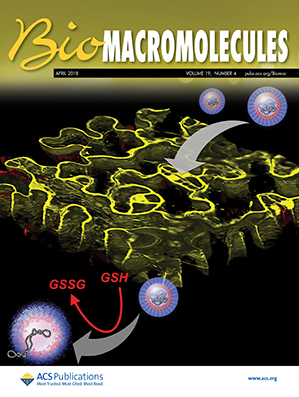自焚聚苯醚基两亲体中端基裁剪和自组装行为的反向嵌段序列。
IF 5.4
2区 化学
Q1 BIOCHEMISTRY & MOLECULAR BIOLOGY
引用次数: 0
摘要
本文报道了一种自焚型聚苯醚(PBE)两亲体的模块化设计,可以精确控制聚合物链结构、端基位置和降解行为。通过调整片段序列和暴露活性端基,这些两亲体在外部刺激下进行有效的头到尾解聚。单体的结构变化使胶束形成,端基显示在表面,而亲水性块中的羧酸含量影响整体胶束形态。所得到的胶束在水环境中可降解,当与常规表面活性剂结合时,可以转化为球形结构。作为概念验证,小分子货物成功地从混合胶束中按需装载和释放。该设计平台提供了一种多功能的途径来创建具有可调组装、降解和控制释放能力的功能性、刺激响应性表面活性剂。本文章由计算机程序翻译,如有差异,请以英文原文为准。
Reverse Block Sequence in Self-Immolative Poly(benzyl ether)-Based Amphiphiles for Tailoring End Groups and Self-Assembly Behavior
This paper reports a modular design of self-immolative poly(benzyl ether) (PBE) amphiphiles that allows precise control over polymer chain structure, end-group placement, and degradation behavior. By tuning block sequences and exposing reactive end groups, these amphiphiles undergo efficient head-to-tail depolymerization upon external stimuli. Structural variations in the monomers enable micelle formation with end groups displayed on the surface, while the carboxylate content in the hydrophilic block influences global micelle morphology. The resulting micelles are degradable in aqueous environments and can transform into spherical structures when combined with conventional surfactants. As a proof of concept, small-molecule cargos were successfully loaded and released from the mixed micelles on demand. This design platform offers a versatile route to create functional, stimulus-responsive surfactants with tunable assembly, degradation, and controlled release capabilities.
- Download: Download high-res image (45KB)
- Download: Download full-size image
求助全文
通过发布文献求助,成功后即可免费获取论文全文。
去求助
来源期刊

Biomacromolecules
化学-高分子科学
CiteScore
10.60
自引率
4.80%
发文量
417
审稿时长
1.6 months
期刊介绍:
Biomacromolecules is a leading forum for the dissemination of cutting-edge research at the interface of polymer science and biology. Submissions to Biomacromolecules should contain strong elements of innovation in terms of macromolecular design, synthesis and characterization, or in the application of polymer materials to biology and medicine.
Topics covered by Biomacromolecules include, but are not exclusively limited to: sustainable polymers, polymers based on natural and renewable resources, degradable polymers, polymer conjugates, polymeric drugs, polymers in biocatalysis, biomacromolecular assembly, biomimetic polymers, polymer-biomineral hybrids, biomimetic-polymer processing, polymer recycling, bioactive polymer surfaces, original polymer design for biomedical applications such as immunotherapy, drug delivery, gene delivery, antimicrobial applications, diagnostic imaging and biosensing, polymers in tissue engineering and regenerative medicine, polymeric scaffolds and hydrogels for cell culture and delivery.
 求助内容:
求助内容: 应助结果提醒方式:
应助结果提醒方式:


